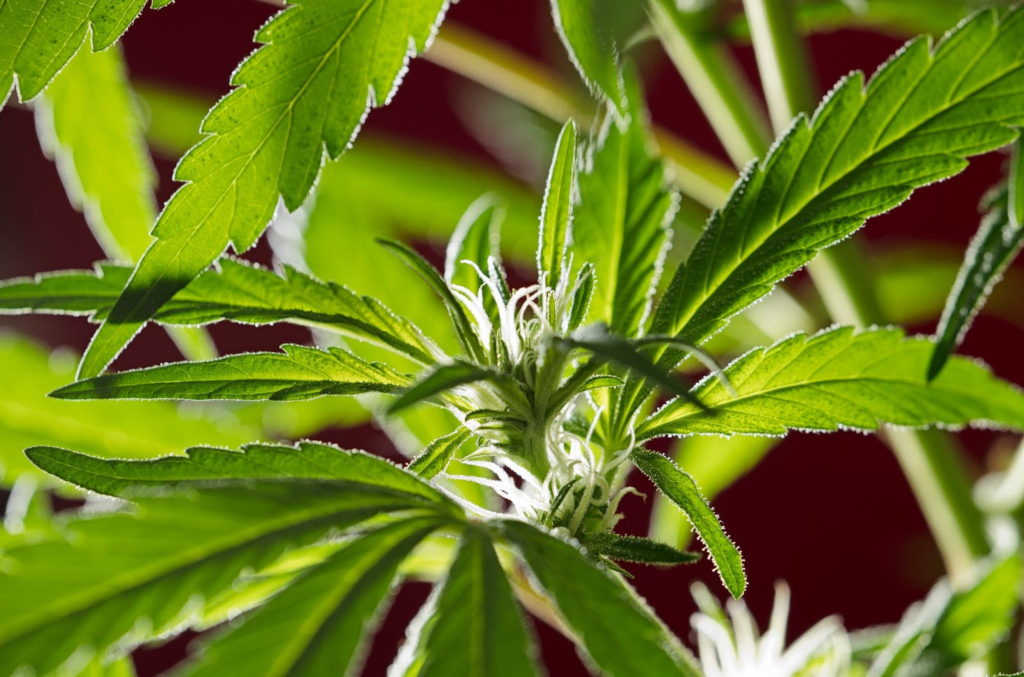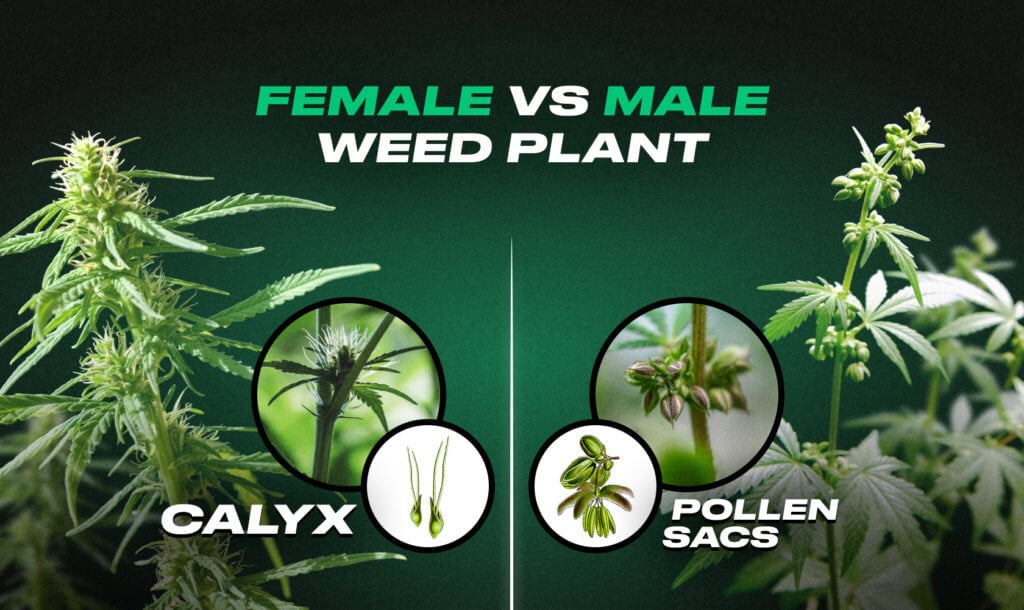Male vs. Female Weed Plants: How to Identify Cannabis Gender
How do you differentiate male vs. female weed plants? What are the benefits of identifying your crop’s gender?
Cannabis plants are similar to most other living things, as they also have sexual organs and gender identities. The reproductive system of a cannabis plant determines its ultimate value and characteristics at harvest time.
Male and female cannabis crops are beneficial to growers and consumers in different ways. As a result, breeders choose to cultivate feminized or regular cannabis strains to attain specific goals.
Male vs. female cannabis: Let’s talk about weed plant gender
Weed is dioecious as it features two sexes. Every individual plant possesses a particular gender. It’s usually either female or male, but there are also rare cases of hermaphrodite crops which are triggered by stress or the use of certain cultivation techniques.
Although all genders play a vital role in flower development, female crops are typically more desirable.
Only a female weed plant can produce buds with abundant amounts of cannabidiol (CBD) and tetrahydrocannabinol (THC). These compounds are the main psychoactive and therapeutic ingredients responsible for weed’s effects.
As a result, many breeders grow feminized seeds, which develop into female-only plants 99% of the time. They save you the stress of identifying cannabis gender and separating males. On the other hand, regular seeds produce an even split of 50% female and 50% male plants.
Since male marijuana crops don’t produce cannabinoid-rich buds, growers often remove them once they’re able to identify their gender. Male cannabis plants can also fertilize females, causing them to create seeds instead of flowers.
Hermaphrodite weed crops are typically female plants that produce pollen sacs. Stress is the main factor that makes them have the characteristics of both male and female plants. Although they produce buds, the pollen ensures the buds are filled with seeds.
The difference between male and female weed plants
Cannabis plants have distinct sex organs, allowing you to identify them with the naked eye towards the end of their life cycle. There’s a brief phase called the pre-flowering stage that allows you to determine cannabis sex before flowering.
How to identify a female weed plant

To identify a female weed plant, examine its node, the area where the branches sprout out of the crop’s stems.
Female cannabis crops look more compact and hairy than their male counterparts. When they enter the pre-flowering stage, their nodes contain a rounded, protruded calyx and two stigmas that make up the pistils.
The pistils are delicate white strands that represent the female sex organs. The hair and other components appear on the plant once it starts flowering. This process may take several months if cultivating cannabis crops outdoors.
The stigmas and pistils usually grow on the crop’s topmost regions but may sometimes appear on its lower parts. These female reproductive organs can receive pollen from male plants and start producing seeds.
Some female cannabis crops don’t produce pistils during the pre-flowering stage. This issue makes it difficult to determine cannabis plant gender with reproductive organs.
You can also identify female plants in the later stage of their life. The crops enter the blooming stage and start developing buds. This period lasts for around 6–12 weeks, depending on various factors.
Although male cannabis plants also experience the vegetative and flowering states, they don’t produce buds.
How to identify a male weed plant

When identifying male cannabis plants, look at the area between the stalks and nodes. The space contains tiny green balls called pollen sacs, which look like a tiny cluster of grapes in their early stages.
While the sacs may resemble buds in the early stages, they don’t feature white hair strands associated with female weed. Once these pods open, they release pollen, small sugar-like grains that pollinate female plants. When empty, the pouches look like small petals in flowers.
Morphological characteristics can also show the difference between male and female marijuana plants. Female crops are usually shorter, wider, and bushier than males. Before leaving the vegetative state, male plants may look like a spade and have thicker stalks.
Since certain conditions can alter the plant structure, don’t rely on only morphological features for identifying weed gender. Combine these characteristics with the examination of sex organs as you compare male vs. female weed plants.

Hermaphrodite cannabis plants
While most weed plants are either female or male, some can be hermaphroditic. This means an individual crop contains the sexual organs of both genders. Poor genetics, nutrient deficiency, excess heat, disease, and improper light are the primary causes of this condition.
Hermaphrodite weed comes in two categories:
- Mixed-gender: The male sex organs sprout from the existing female buds, causing both reproductive systems to exist in the same place.
- True hermaphrodite: Different parts of a single cannabis plant have pollen sacs and flowers.
Studies show the mechanism behind hermaphroditism isn’t fully understood. While the male organs tend to develop before the female ones, the reverse may occur in some plants.
The presence of two sex organs enables hermaphrodite weed crops to function like both genders. They produce buds like a female weed plant and also release pollen from their male reproductive system.
Identifying hermaphrodite cannabis is usually easy, as the two sexual organs become obvious before the crop reaches maturity. Some plants may not experience hermaphroditism until the end of their flowering stage.

Why identify the gender & differentiate male vs. female weed plants
If you’re a grower, learning how to identify male and female weed plants is essential. Although both genders are valuable, they serve different purposes. Determining weed gender helps you choose the preferred sex of your crop.
Female marijuana plants produce buds rich in cannabinoids with high potency. Select this gender if you want to harvest high-quality marijuana nugs for consumption purposes.
Male cannabis crops produce pollen, which can travel long distances and fertilize female cannabis plants. This process leads to the creation of seeds rather than buds. If both sexes grow in the same place, you run the risk of cross-pollination.
Fertilization causes female weed crops to concentrate their energy on making seeds, affecting their ability to produce buds. Remove hermaphrodites and male weed plants from your growing space if you want THC-rich flowers.

FAQs
Do you have more queries about male vs. female cannabis? Find the answers to common questions below.
Do male or female cannabis plants have seeds?
Only female cannabis plants can produce seeds. Male crops create and spread pollen to fertilize females, which causes them to make seeds.
Male vs. female: Which sex grows faster?
Male cannabis plants tend to grow faster and bigger than females in the initial developmental phases. They develop sexual characteristics quickly and reach the pre-flowering stage within 3–4 weeks after germination.
Female cannabis crops develop slower and only enter pre-flowering about 4–6 weeks after germination. Certain cannabis variants may mature faster under some conditions.
How can you be sure you’ll grow a female weed plant?
There are several ways to guarantee weed plant gender. To be absolutely sure you get female plants, choose feminized seeds, which are expertly bred with techniques to produce only female crops in 99% of cases.
Do male plants produce buds?
Male weed plants don’t create buds. They only produce pollen sacs, which spread powdery grains and fertilize female crops to produce seeds. This is one of the main differences between male and female weed plants.
Why are female weed plants more valuable?
Growers consider female plants more valuable than males, as they develop THC-rich, trichome-covered buds we’re all familiar with. They look like small mushrooms and produce an abundant amount of terpenes, flavonoids, and cannabinoids, such as THC, CBD, and CBG.
Male cannabis plants don’t develop potent nugs, so many growers prefer not to cultivate them. They’re only useful for breeding new cannabis strains, creating medical extracts, preserving an existing variant, or making hemp paper or fabric.
Should you separate male and female plants?
It depends on your goals. Remove male or hermaphrodite weed plants as soon as you identify them to reduce the risk of cross-pollination if you’re only after the buds. Keep the males around if you want to experiment with different genetics and create new strains.
